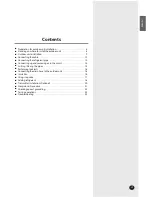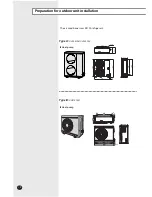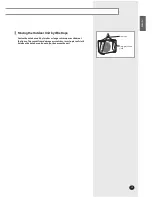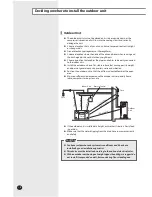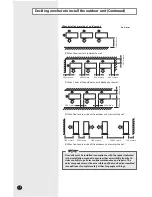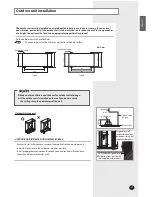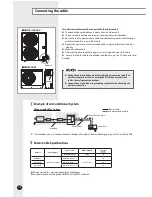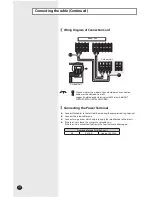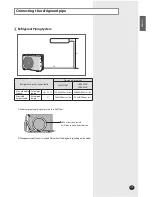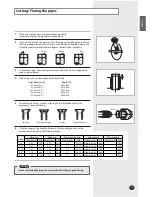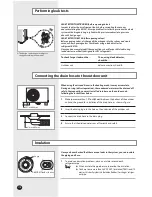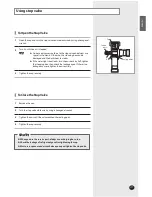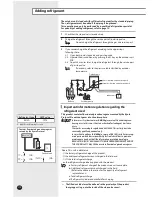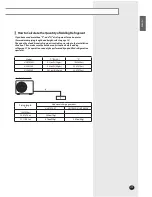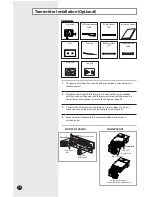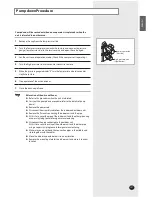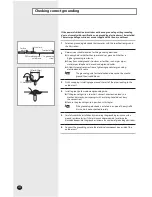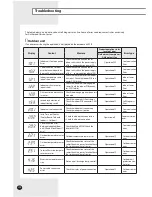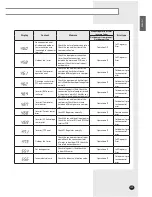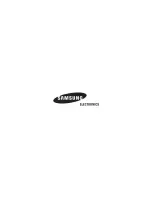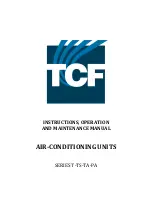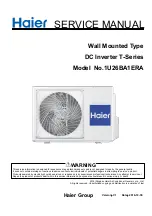
E-
14
Connecting up and removing air in the circuit
A
B
C
D
Outdoor unit
Vacuum
pump
The designs and shape are subject to
change according to the model.
The air in the indoor unit and in the pipe must be purged. If air remains in the
refrigeration pipes, it will affect the compressor either reduce cooling/heating
capacity or lead to a malfuction. Refrigerant for air purging is not charged in
the outdoor unit. Use Vacuum Pump as shown at the right figure.
1
Connect each assembly pipe to the appropriate valve on the outdoor unit and
tighten the flare nut.
2
Referring to the illustration opposite, tighten the flare nut on section B first
manually and then with a torque wrench, applying the following torque.
Outer Diameter
Torque
(
ft.lb
)
6.35 mm(1/4”)
13.2
9.52 mm(3/8”)
31.0
12.70 mm(1/2”)
40.6
15.88 mm(5/8”)
48.0
19.05 mm(3/4”)
73.6
3
Connect the charging hose of low pressure side of manifold gauge to the
packed valve having a service port as shown at the figure.
CAUTION
Make the electrical connection and leave the system into
“stand by mode”. Do not turn on the system.
This is necessary to speed up vacuum operation
(full OPEN position of Electronic Expansion Valve - EEV -).
4
Open the valve of the low pressure side of manifold gauge counterclockwise.
5
Purge the air from the system using vacuum pump for about 10 minutes.
Close the valve of the low pressure side of manifold gauge clockwise.
Make sure that pressure gauge shows -0.1MPa(-76cmHg) after about
10 minutes.
This procedure is very important to avoid a gas leak.
Turn off the vacuum pump.
Remove the hose of the low pressure side of manifold gauge.
6
Set valve cork of both liquid side and gas side of packed valve to the open position.
7
Mount the valve stem nuts and the service port cap to the valve, and tighten
them at the torque of
13.3ft.lb(183kgf.cm)
with a torque wrench.
8
Check for gas leakage.
At this time, especially check for gas leakage from the 3-way valve’s stem
nuts(A port), and from the service port cap.
B
(liquid)
Stem cap
Valve stem
A
(gas)
Connect the indoor and outdoor units using pipes with flared connections (not
supplied). For the lines, use insulated, unwelded, degreased and deoxidized
copper pipe,(Cu DHP type to ISO 1337), suitable for operating pressures of at
least 4200kPa and for a burst pressure of at least 20700kPa.
Copper pipe for hydro-sanitary applications is completely unsuitable.
For sizing and limits (height difference, line length, max. bends,
refrigerant charge, etc.) see “Connecting refrigerant pipe section”.
CAUTION
Summary of Contents for UH070CAV1
Page 26: ......



